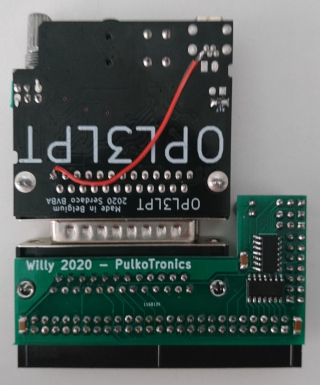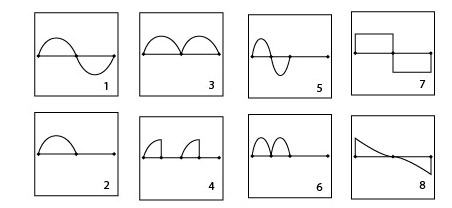Willy
Willy - MIDI and OPL3 Soundcard adapter for CPC
Contents
Demonstrations
- Willy OPL3 on a real CPC demoed by Prodatron
- Willy MIDI and Willy OPL3 emulated on ACE demoed by Offset
- Willy OPL3 emulated on ACE-DL demoed by Roudoudou
- OPL3LPT soundcard reviewed on PC by ChinnyVision
Weblinks
- https://pulkomandy.github.io/shinra.github.io/willy.html
- OPL3 Player Pack Huge pack containing 3887 OPL2/OPL3 tunes to be played on Amstrad CPC
Cost
The cost for a Willy soundcard adapter is 10€. This does not include any soundcard, you have to buy those separately.
Compatible Serdaco soundcards
- S2P soundcard aka Roland MT-32 or General MIDI Wavetable Synth - Datasheet
- OPL3LPT soundcard aka AdLib Gold or Sound Blaster 16 - Datasheet
- OPL2LPT soundcard aka AdLib or Sound Blaster - Datasheet
- CMSLPT soundcard aka Creative Music System or Game Blaster - Datasheet
- TNDLPT soundcard aka PCjr or Tandy Sound - Datasheet
- CVX4 soundcard aka Covox Speech Thing - Technical analysis
I/O Ports
2 ports are used to control the MIDI soundcard: &FEAC for data, and &FEAD for control and status.
3 ports are used to control the OPL3 soundcard: &FEBC and &FEBE are register select ports, and &FEBD is the data port.
OPL3 sound chip
OPL3 is register compatible with OPL2, with twice the number of signal sources, 4 new operator modes, 4 new selectable waveforms, and stereo output.
OPL3 offers 18 FM 2-op chans in its standard mode, but that can be configured:
- One setting converts 3 of the FM chans into a 5-chan FM percussion set
- Another setting pairs 12 of the FM chans into 6 FM 4-op chans
- Both settings can be used at the same time, to obtain 6 FM 4-op chans + 3 FM 2-op chans + 5-chan FM percussion set
Basic Components
The most basic elements of an OPL FM synthesiser are:
- envelope generators, which vary volume over time;
- phase generators, which produce a waveform such as a sine wave at a programmatic rate;
- operators, which combine an envelope generator and a phase generator;
- a global low-frequency oscillator which can provide additional vibrato (i.e. back-and-forth modification of frequency) and tremolo (like vibrato, but for volume) to operators;
- channels, which combine operators to produce a single tone output;
- a distinct rhythm section, which incorporates a noise generator with some of the parts above to provide a few fixed percussion noises.
Logsin and Exponent tables
The OPL3 uses two look-up tables, each containing 256 entries. Source
This is strong evidence that the OPL chip produces the sound without any multiplications, using for frequency modulated (actually phase modulated) synthesis the formula:
out = exp(logsin(phase2 + exp(logsin(phase1) + gain1)) + gain2)
Exponential table:
x = 0..255, y = round((power(2, x/256)-1)*1024)
When such a table is used for calculation of the exponential, the table is read at the position given by the 8 LSB's of the input. The value + 1024 (the hidden bit) is then the significand of the floating point output and the yet unused MSB's of the input are the exponent of the floating point output.
Log-sin table:
x = 0..255, y = round(-log(sin((x+0.5)*pi/256/2))/log(2)*256)
This is the first (rising) quarter of sine wave. The rest can be constructed by flipping all the bits of x and/or by changing the sign of the samples.
Waveforms
The original OPL only has access to the sine wave.
From the OPL2 onwards other waves are also available, specifically a half sine (i.e. the positive part only, silence for the second half of the period), rectified sine (the positive part repeated twice per cycle) or quarter sine (just the first ramp from 0 to 1, repeated twice, providing harmonics a lot like a sawtooth).
The OPL3 goes even further, adding some extra sine options plus a square wave and a logarithmic sawtooth.
FM Percussion Set
FM synthesis does a great job relative to its hardware requirements at reproducing melodic instruments but isn't especially useful for harsh percussion noises like drums. Yamaha provides separate drum noises for this purpose. The programmer has to forfeit three channels of regular FM synthesis, freeing up six operators for five rhythm instruments.
A global random level generator is implemented for this mode; it's a standard LFSR just like the noise generator on simple chips like the AY-3-8910 or SN76489, so it provides a one-bit semi-random output.
The OPL can then generate:
- a bass drum, which is just another FM noise;
- a tom tom, which is the unmodulated output of a single operator;
- a snare drum, which combines the phase of a single operator with the random noise bit;
- a cymbal which XORs six bits from the phase of two operators;
- a high-hat, which uses the same XOR as the cymbal and combines it with the random noise bit.

